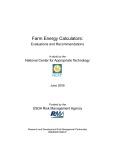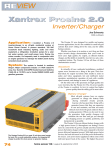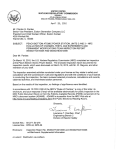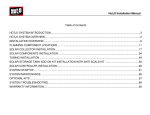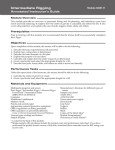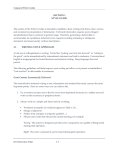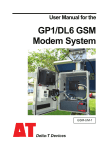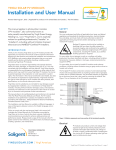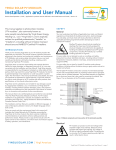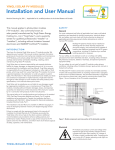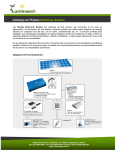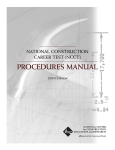Download SOLAR PHOTOVOLTAIC SYSTEMS INSTALLER
Transcript
SOLAR PHOTOVOLTAIC SYSTEMS INSTALLER 57105-11 Maintenance and Troubleshooting 57104-11 System Installation and Inspection 57103-11 System Design 57102-11 Site Assessment 57101-11 Introduction to Solar Photovoltaics Core Curriculum: Introductory Craft Skills This course map shows all of the modules in Solar Photovoltaic Systems Installer. The suggested training order begins at the bottom and proceeds up. Skill levels increase as you advance on the course map. The local Training Program Sponsor may adjust the training order. ix Introduction to Solar Photovoltaics Annotated Instructor’s Guide Module 57101-11 Module Overview This module is designed for trainees who wish to pursue a career in solar energy. It covers the basic concepts of PV systems and their components. It also explains how PV systems are sized, designed, and installed. Successful completion of this module will help prepare trainees for the North American Board of Certified Energy Practitioners (NABCEP) PV Entry Level Exam. Prerequisites Prior to training with this module, it is recommended that the trainee shall have successfully completed Core Curriculum. It is also suggested that the trainee shall have completed the following modules from the Electrical curriculum: Electrical Level One, Modules 26101 through 26111; Electrical Level Two, Modules 26201, 26205, 26206, and 26208 through 26211; Electrical Level Three, Modules 26301 and 26302; and Electrical Level Four, Modules 26403 and 26413. Objectives Upon completion of this module, the trainee will be able to do the following: 1. 2. 3. 4. 5. 6. 7. 8. 9. 10. 11. 12. Identify photovoltaic (PV) applications and advantages. Identify system components and their functions. Identify safety hazards associated with PV installations. Trace a basic electrical circuit and perform calculations using Ohm’s law. List PV system sizing considerations. Identify PV electrical and mechanical system design considerations. Describe the tasks required to complete a site analysis. Identify the effects of the environment on panel output. Describe how to install a simple grid-connected PV system. Explain how to assess system operation and efficiency. Recognize the tasks required when performing PV maintenance and troubleshooting. Identify appropriate codes and standards concerning installation, operation, and maintenance of PV systems and equipment. Performance Tasks This is a knowledge-based module; there are no performance tasks. Materials and Equipment Markers/chalk Pencils and scratch paper Whiteboard/chalkboard Solar Photovoltaic Systems Installer PowerPoint® Presentation Slides (ISBN 978-0-13-257135-7) Multimedia projector and screen Computer Appropriate personal protective equipment Access to various installed PV systems Digital AC/DC meter Clamp-on ammeter Pyranometer Infrared thermal device Torque wrench Sun path calculator Site survey checklist Angle finder Camera Compass Calculator Tape measure Ladder Various types of solar panels and mounting system components Inverter Batteries (continued) Charge controller AC and DC disconnects Panel with breaker for inverter connection Conduit and wire Copy of the latest edition of the National Electrical Code® (NEC®) Module Examination* * Single-module AIG purchases include the printed exam and performance task sheet. If you have purchased the perfect-bound version of this title, download these materials from the IRC using your access code. Safety Considerations Ensure that the trainees are equipped with appropriate personal protective equipment and know how to use it properly. Ensure that all trainees are briefed on appropriate field safety procedures, including fall protection, electrical hazards, sun exposure, and battery hazards. If the training center does not have various simple PV systems set up on site, this module will require that the trainees visit one or more job sites in order to view installed PV systems. Ensure that trainees are briefed on site safety policies prior to any site visits. Additional Resources This module presents thorough resources for task training. The following resource material is suggested for further study. IEEE 1547, Standard for Interconnecting Distributed Resources with Electric Power Systems, Latest Edition. Los Alamitos, CA: Institute of Electrical and Electronics Engineers (IEEE). National Electrical Code® (NFPA 70®), Latest Edition. National Fire Protection Association (NFPA): Quincy, MA. Occupational Safety and Health Standard 1910.302, Electric Utilization Systems, Latest Edition. Washington, DC: OSHA Department of Labor, U.S. Government Printing Office. Photovoltaic Systems, Second Edition. James P. Dunlop. Orland Park, IL: American Technical Publishers. Standard for Electrical Safety in the Workplace® (NFPA 70E), Latest Edition. National Fire Protection Association (NFPA): Quincy, MA. UL Standard 1703, UL Standard for Safety, Flat-Plate Photovoltaic Modules and Panels, Latest Edition. Camas, WA: Underwriters Laboratories. UL Standard 1741, Standard for Inverters, Converters, Controllers and Interconnection System Equipment for Use with Distributed Energy Resources, Latest Edition. Camas, WA: Underwriters Laboratories. Uniform Solar Energy Code, Latest Edition. Ontario, CA: International Association of Plumbing and Mechanical Officials (IAPMO). Teaching Time for This Module An outline for use in developing your lesson plan is presented below. Note that each Roman numeral in the outline equates to one session of instruction. Each session has a suggested time period of 2½ hours. This includes 10 minutes at the beginning of each session for administrative tasks and one 10-minute break during the session. Approximately 40 hours are suggested to cover Introduction to Solar Photovoltaics. You will need to adjust the time required for hands-on activity and testing based on your class size and resources. Topic Planned Time Sessions I and II. Introduction; Applications A. Introduction B. Applications 1. Standalone Systems 2. Grid-Connected Systems 3. Grid-Interactive Systems 4. Utility-Scale Solar Generating Systems ____________ ____________ ____________ ____________ ____________ ____________ Session III. Ohm’s Law and Power A. Ohm’s Law and Power 1. Applying Ohm’s Law to Series and Parallel Circuits 2. Ohm’s Law and Power 3. Series and Parallel Circuits in Solar PV Systems 4. Peak Sun and Power ____________ ____________ ____________ ____________ ____________ Sessions IV and V. PV System Components A. PV System Components 1. PV Panels 2. Inverters 3. Batteries 4. Charge Controllers 5. BOS Components ____________ ____________ ____________ ____________ ____________ ____________ Session VI. Safety Considerations in PV Systems A. Safety Considerations in PV Systems 1. Fall Protection 2. Battery Hazards 3. Electrical Hazards 4. Meter Safety ____________ ____________ ____________ ____________ ____________ Sessions VII and VIII. Site Assessment A. Site Assessment 1. Customer Interview 2. Power Consumption 3. Roof Evaluation 4. Array Orientation 5. Equipment Location ____________ ____________ ____________ ____________ ____________ ____________ Topic Planned Time Sessions IX and X. System Design A. System Design 1. Panel Nameplate Data 2. Solar Array Sizing 3. Inverter Selection 4. Battery Bank Sizing 5. Selecting a Charge Controller 6. Adjusting PV Conductors ____________ ____________ ____________ ____________ ____________ ____________ ____________ Sessions XI and XII. Installation A. Installation 1. Forces Exerted on the Panels/Support System 2. Roof-Mounted Installations 3. Ground-Mounted Installation 4. Electrical System Installation 5. Assessing System Output Power ____________ ____________ ____________ ____________ ____________ ____________ Sessions XIII and XIV. Maintenance; Troubleshooting A. Maintenance B. Troubleshooting 1. Loose or Corroded System Connections 2. Inverter Losses 3. Heat Fade 4. Burnt Terminals 5. Bypass Diode Failure ____________ ____________ ____________ ____________ ____________ ____________ ____________ Sessions XV. Codes and Standards; Emerging Technologies A. Codes and Standards B. Emerging Technologies ____________ ____________ Session XVI. Review and Testing A. Module Review B. Module Examination 1. Trainees must score 70 percent or higher to receive recognition from NCCER. 2. Record the testing results on Training Report Form 200, and submit the results to the Training Program Sponsor. ____________ ____________ Site Assessment Annotated Instructor’s Guide Module 57102-11 Module Overview A thorough site assessment is essential to the installation of an efficient system that meets the customer’s needs. This module introduces the trainee to the site assessment process for a photovoltaic system. Objectives Upon completion of this module, the trainee will be able to do the following: 1. Determine customer needs: • Determine electrical load and energy use by review of utility bills, meter readings, measurements, and/or customer interviews. • Estimate and/or measure the peak load demand and average daily energy use for all connected loads. 2. Assess any site-specific safety hazards and/or installation considerations. 3. Identify and use the tools and equipment required for conducting site surveys for PV installations. 4. Identify, select, and sketch a suitable location for PV array installation, including proper orientation, sufficient area, adequate solar access, and structural integrity. 5. Select suitable locations for installing inverters, control(s), batteries, and other components. • Identify essential loads for battery systems. • Identify opportunities for the use of energy-efficient equipment/appliances, conservation, and energy management practices. 6. Acquire and interpret site solar radiation and temperature data to establish performance expectations and use in electrical system calculations. Prerequisites Prior to training with this module, it is recommended that the trainee shall have successfully completed Core Curriculum and Solar Photovoltaic Systems Installer, Module 57101-11. It is also suggested that the trainee shall have successfully completed the following modules from the Electrical curriculum: Electrical Level One, Modules 26101 through 26111; Electrical Level Two, Modules 26201, 26205, 26206, and 26208 through 26211; Electrical Level Three, Modules 26301 and 26302; and Electrical Level Four, Modules 26403 and 26413. Performance Task Under the supervision of the instructor, the trainee should be able to do the following: 1. Given the results of a customer interview and the sample house drawing provided, complete a site survey and checklist. Materials and Equipment Markers/chalk Pencils and scratch paper Whiteboard/chalkboard Solar Photovoltaic Systems Installer PowerPoint® Presentation Slides (ISBN 978-0-13-257135-7) Multimedia projector and screen Computers with Internet access Appropriate personal protective equipment Selection of assessment tools Sample electric bills Pictures of sagging or obviously bad roofs, marginal roofs, and good roofs Picture with roof and lot dimensions, roof angle, and number of panels Several addresses with good aerial views available on the Internet Compass Solar Pathfinder™, if possible (continued) Sufficient copies of a completed customer interview Sufficient copies of the sample house drawing Module Examinations* Performance Profile Sheets* * Single-module AIG purchases include the printed exam and performance task sheet. If you have purchased the perfect-bound version of this title, download these materials from the IRC using your access code. Safety Considerations Ensure that the trainees are equipped with appropriate personal protective equipment and know how to use it properly. Review safety guidelines associated with working on or around photovoltaic systems, including fall protection. Emphasize the importance of proper housekeeping. Additional Resources This module presents thorough resources for task training. The following resource material is suggested for further study. Aerial photographs: Terraserver: www.terraserver.com. Google Earth: www.google.com. USGS: http://edcsns17.cr.usgs.gov. AMtec Solar (combiners) website: www.amtecsolar.com. Electric Power Glossary of Terms: www.osha.gov. Florida Solar Energy Center website: www.fsec.ucf.edu. National Geophysical Data Center website: www.ngdc.noaa.gov. National Oceanic and Atmospheric Administration website: www.noaa.gov. Solar Pathfinder™ website: www.solarpathfinder.com. Solar Power Calculator website: www.findsolar.com. Solar Source Institute website: www.solarsource.net. Surrette/Rolls Battery website: www.surrette.com. University of Oregon Solar Radiation Monitoring Laboratory website: solardat.uoregon.edu. Teaching Time for This Module An outline for use in developing your lesson plan is presented below. Note that each Roman numeral in the outline equates to one session of instruction. Each session has a suggested time period of 2½ hours. This includes 10 minutes at the beginning of each session for administrative tasks and one 10-minute break during the session. Approximately 10 hours are suggested to cover Site Assessment. You will need to adjust the time required for hands-on activity and testing based on your class size and resources. Because laboratories often correspond to Performance Tasks, the proficiency of the trainees may be noted during these exercises for Performance Testing purposes. Topic Planned Time Session I. Introduction; Determining Customer Needs A. Introduction 1. Assessment Tools and Equipment B. Determining Customer Needs 1. Energy Loads 2. Available Sunlight 3. Mounting Options ____________ ____________ ____________ ____________ ____________ ____________ Topic Planned Time Session II. Mounting Surface Information; Acquiring and Interpreting Site Solar Data A. Mounting Surface Information 1. Inspecting Proposed Installation Areas 2. Inspecting Attic Spaces 3. Roofing Materials 4. Spacing 5. Anchoring B. Acquiring and Interpreting Site Solar Data 1. Identifying Sun Paths and Intensity Levels 2. Shading at the Customer’s Location ____________ ____________ ____________ ____________ ____________ ____________ ____________ ____________ ____________ Session III. Locations for BOS Components; Documenting Site Assessment; New Technology A. Locations for BOS Components 1. Support and Security Structures 2. Combiners 3. Charge Controllers 4. Batteries 5. Inverters 6. Disconnects 7. Grounding B. Documenting Site Assessment C. New Technology D. Laboratory Given the results of a customer interview and the sample house drawing provided, have the trainees complete a site survey and checklist. This laboratory corresponds to Performance Task 1. Session IV. Review and Testing A. Review B. Module Examination 1. Trainees must score 70 percent or higher to receive recognition from NCCER. 2. Record the testing results on Training Report Form 200, and submit the results to the Training Program Sponsor. C. Performance Testing 1. Trainees must perform each task to the satisfaction of the instructor to receive recognition from NCCER. If applicable, proficiency noted during laboratory exercises can be used to satisfy the Performance Testing requirements. 2. Record the testing results on Training Report Form 200, and submit the results to the Training Program Sponsor. ____________ ____________ ____________ ____________ ____________ ____________ ____________ ____________ ____________ ____________ ____________ ____________ ____________ ____________ System Design Annotated Instructor’s Guide Module 57103-11 Module Overview This module describes system design considerations, including array configurations, component selection, and wire sizing. It also covers bonding, grounding, and the selection of overcurrent protection and disconnects. Prerequisites Prior to training with this module, it is recommended that the trainee shall have successfully completed Core Curriculum and Solar Photovoltaic Systems Installer, Modules 57101-11 and 57102-11. It is also suggested that the trainee shall have successfully completed the following modules from the Electrical curriculum: Electrical Level One, Modules 26101 through 26111; Electrical Level Two, Modules 26201, 26205, 26206, and 26208 through 26211; Electrical Level Three, Modules 26301 and 26302; and Electrical Level Four, Modules 26403 and 26413. Objectives Upon completion of this module, the trainee will be able to do the following: 1. Identify appropriate system designs and array configurations based on user loads, customer expectations, and site conditions. 2. Determine the size and capacities for major system components based on user load, desired energy production, autonomy requirements, and costs. 3. Determine the PV module layout, orientation, and mounting method for optimum system production and integrity. 4. Determine the ampacity requirement for all components and wiring of the PV system. 5. Select the appropriate conductor types and sizes for each portion of the electrical circuit. 6. Identify the appropriate size, rating, and location of required overcurrent protection and power disconnect devices. 7. Determine the appropriate size, rating, and location for bonding, grounding, and surge suppression. Performance Task Under the supervision of the instructor, the trainee should be able to do the following: 1. Given a completed site assessment, design a grid-connected PV system. Materials and Equipment Markers/chalk Pencils and scratch paper Whiteboard/chalkboard Solar Photovoltaic Systems Installer PowerPoint® Presentation Slides (ISBN 978-0-13-257135-7) Multimedia projector and screen Computers with Internet access Appropriate personal protective equipment Several multimeters A list of battery requirements including: Current load Inverter efficiency DC system voltage Days of autonomy Battery design discharge limit Several battery catalogs Several solar panel specification sheets PV system, working Photos of several site locations, with their city, state, and insolation factors Two or three copies of the NEC® A couple of wire specifications for the trainees to determine wire sizes An electrical diagram of a PV system with the grounding and disconnects removed Factor values for determining array size Completed site assessment Module Examinations* Performance Profile Sheets* * Single-module AIG purchases include the printed exam and performance task sheet. If you have purchased the perfect-bound version of this title, download these materials from the IRC using your access code. Safety Considerations Ensure that the trainees are equipped with appropriate personal protective equipment and know how to use it properly. Review safety guidelines associated with working on or around solar PV systems. Emphasize the importance of proper housekeeping. Additional Resources This module presents thorough resources for task training. The following resource material is suggested for further study. IEEE 1547, Standard for Interconnecting Distributed Resources with Electric Power Systems, Latest Edition. Los Alamitos, CA: Institute of Electrical and Electronics Engineers (IEEE). National Electrical Code® (NFPA 70®), Latest Edition. National Fire Protection Association (NFPA): Quincy, MA. Occupational Safety and Health Standard 1910.302, Electric Utilization Systems, Latest Edition. Washington, DC: OSHA Department of Labor, U.S. Government Printing Office. Photovoltaic Systems, Second Edition. James P. Dunlop. Orland Park, IL: American Technical Publishers. Standard for Electrical Safety in the Workplace® (NFPA 70E®), Latest Edition. National Fire Protection Association (NFPA): Quincy, MA. Solar insolation for U.S. major cities: www.solar4power.com. Solar panels, solar power www.bdbatteries.com. generation, and photovoltaic system comparison chart: UL Standard 1703, UL Standard for Safety, Flat-Plate Photovoltaic Modules and Panels, Latest Edition. Camas, WA: Underwriters Laboratories. UL Standard 1741, Standard for Inverters, Converters, Controllers and Interconnection System Equipment for Use with Distributed Energy Resources , Latest Edition. Camas, WA: Underwriters Laboratories. Uniform Solar Energy Code, Latest Edition. Ontario, CA: International Association of Plumbing and Mechanical Officials (IAPMO). Teaching Time for This Module An outline for use in developing your lesson plan is presented below. Note that each Roman numeral in the outline equates to one session of instruction. Each session has a suggested time period of 2½ hours. This includes 10 minutes at the beginning of each session for administrative tasks and one 10-minute break during the session. Approximately 25 hours are suggested to cover System Design. You will need to adjust the time required for hands-on activity and testing based on your class size and resources. Because laboratories often correspond to Performance Tasks, the proficiency of the trainees may be noted during these exercises for Performance Testing purposes. Topic Planned Time Sessions I–VII. Introduction; Stand-Alone System Design; System Wiring A. Introduction B. Stand-Alone System Design 1. The Electrical Load 2. Battery Selection 3. Solar PV Panel Selection 4. Charge Controller Selection 5. Inverters 6. System Design and Equipment Review ____________ ____________ ____________ ____________ ____________ ____________ ____________ ____________ Topic C. System Wiring 1. Wire, Cable, and Raceway 2. Wiring Diagram 3. Solar Array Wiring 4. Battery and Controller Wiring 5. Inverter Wiring 6. Overcurrent Protection and Disconnects Sessions VIII–IX. Grid-Tied Systems A. Grid-Tied Systems 1. Grid-Tied System Component Selection 2. PV System Grid Interface B. Laboratory Given a completed site assessment, have trainees design a grid-connected PV system. This laboratory corresponds to Performance Task 1. Session X. Review and Testing A. Review B. Module Examination 1. Trainees must score 70 percent or higher to receive recognition from NCCER. 2. Record the testing results on Training Report Form 200, and submit the results to the Training Program Sponsor. C. Performance Testing 1. Trainees must perform each task to the satisfaction of the instructor to receive recognition from NCCER. If applicable, proficiency noted during laboratory exercises can be used to satisfy the Performance Testing requirements. 2. Record the testing results on Training Report Form 200, and submit the results to the Training Program Sponsor. Planned Time ____________ ____________ ____________ ____________ ____________ ____________ ____________ ____________ ____________ ____________ ____________ ____________ ____________ ____________ System Installation and Inspection Annotated Instructor’s Guide Module 57104-11 Module Overview This module explains the process of installing a solar photovoltaic (PV) system, inspecting the entire system, and then activating the system. Prerequisites Prior to training with this module, it is recommended that the trainee shall have successfully completed Core Curriculum and Solar Photovoltaic Systems Installer, Modules 57101-11 through 57103-11. It is also suggested that the trainees shall have successfully completed the following modules from the Electrical curriculum: Electrical Level One, Modules 26101 through 26111; Electrical Level Two, Modules 26201, 26205, 26206, and 26208 through 26211; Electrical Level Three, Modules 26301 and 26302; and Electrical Level Four, Modules 26403 and 26413. Objectives Upon completion of this module, the trainee will be able to do the following: 1. Review the site assessment report, system design documents, and permits, and inspect the installation site. 2. Perform a job safety analysis (JSA) and deploy safety systems as needed. 3. Use system drawings and manufacturer’s instructions to plan the installation and to inventory the project materials and tools needed for the job. 4. Locate structural members and install mounting hardware and raceway. 5. Inspect photovoltaic (PV) system components prior to installation. 6. Install the mechanical parts of the PV modules (panels) and balance-of-system components. 7. Install, label, and terminate electrical wiring and devices in accordance with local and national codes. 8. Activate and test the system to verify overall system operation. Performance Task Under the supervision of the instructor, the trainee should be able to do the following: 1. Install and commission a system. Materials and Equipment Markers/chalk Pencils and scratch paper Whiteboard/chalkboard Solar Photovoltaic Systems Installer PowerPoint® Presentation Slides (ISBN 978-0-13-257135-7) Multimedia projector and screen Computers with Internet access Appropriate personal protective equipment Roof anchors Harnesses and lanyards Air-filtering respirator ESD protection Sufficient drills, torque wrenches, and tools for panel installation Stud finder Multimeter Hydrometer Set of panel output specifications Bill of Materials for a PV system installation Charge controller and user manual Inverter and user manual Combiner and user manual Disconnect switches Wiring diagram for solar PV system Wire and raceway catalogs Job safety analysis for each task in an installation Site design plans Section of a roof with shingles Roofing sealant (continued) FLA batteries, dry Electrolyte Flange connections, both good and slightly damaged Sufficient standoffs, mounting beams, grounding lugs, sliders, and associated hardware End clamps, 16 sets Mid clamps, 6 sets Solar panels, boxed Module Examinations* Performance Profile Sheets* * Single-module AIG purchases include the printed exam and performance task sheet. If you have purchased the perfect-bound version of this title, download these materials from the IRC using your access code. Safety Considerations Ensure that the trainees are equipped with appropriate personal protective equipment and know how to use it properly. Review safety guidelines associated with working on or near PV systems. Emphasize the importance of proper housekeeping. Additional Resources This module presents thorough resources for task training. The following resource material is suggested for further study. AMtec Solar (combiners) website: www.amtecsolar.com. Florida Solar Energy Center website: www.fsec.ucf.edu. Sample wiring diagram for solar PV system: www.freesunpower.com. Solar panel terms: www.osha.gov. Surrette/Rolls Battery website: www.surrette.com. Solar Source Institute website: www.solarsource.net. University of Oregon’s Solar Radiation Monitoring Laboratory website: http://solardat.uoregon.edu. Teaching Time for This Module An outline for use in developing your lesson plan is presented below. Note that each Roman numeral in the outline equates to one session of instruction. Each session has a suggested time period of 2½ hours. This includes 10 minutes at the beginning of each session for administrative tasks and one 10-minute break during the session. Approximately 60 hours are suggested to cover System Installation and Inspection. You will need to adjust the time required for hands-on activity and testing based on your class size and resources. Because laboratories often correspond to Performance Tasks, the proficiency of the trainees may be noted during these exercises for Performance Testing purposes. Topic Session I. Introduction; Job Preparations A. Introduction B. Job Preparations 1. Reviewing Site Assessment Reports 2. Reviewing System Design Plans 3. Inspecting Building Permits 4. Inspecting Installation Sites Planned Time ____________ ____________ ____________ ____________ ____________ ____________ Topic Sessions II and III. Safety A. Safety 1. Housekeeping 2. Fall Protection 3. Containment 4. PPE and Heat or Sun Protection 5. Material Handling 6. Batteries 7. Electrical Safety Sessions IV–VII. Job Planning and Inventory of Materials and Tools; Installing Mounting Hardware and Raceways A. Job Planning and Inventory of Materials and Tools 1. Mounting Hardware 2. Panels, Combiners, and Wiring to BOS Components 3. BOS Components B. Installing Mounting Hardware and Raceways 1. Preparing Installation Site 2. Installing Mounting Hardware Sessions VIII and IX. Inspections of PV Components Prior to Installation A. Inspections of PV Components Prior to Installation 1. Inspecting PV Panels 2. Inspecting Combiner and DC Disconnect Switch 3. Inspecting Charge Controller and Batteries 4. Inspecting Inverters and AC Circuit Breakers 5. Inspecting Raceway and Wiring Sessions X–XXIII. Installing PV Modules and BOS Components; Installing, Labeling, and Terminating Wiring per Code; Activating and Testing PV System to Verify Operations A. Installing PV Modules and BOS Components 1. Installing the Combiner 2. Installing a DC Disconnect Switch 3. Installing the Batteries 4. Installing the Charge Controller 5. Installing the Inverter 6. Installing the PV Panels B. Installing, Labeling, and Terminating Wiring per Code 1. Labeling 2. Checking Terminations C. Activating and Testing PV System to Verify Operations 1. Final System Walkdown 2. System Activation and Testing D. Laboratory Have trainees install and commission a system. This laboratory corresponds to Performance Task 1. Planned Time ____________ ____________ ____________ ____________ ____________ ____________ ____________ ____________ ____________ ____________ ____________ ____________ ____________ ____________ ____________ ____________ ____________ ____________ ____________ ____________ ____________ ____________ ____________ ____________ ____________ ____________ ____________ ____________ ____________ ____________ ____________ ____________ ____________ ____________ ____________ Topic Planned Time Session XXIV. Review and Testing ____________ A. Review ____________ B. Module Examination 1. Trainees must score 70 percent or higher to receive recognition from NCCER. 2. Record the testing results on Training Report Form 200, and submit the results to the Training Program Sponsor. ____________ C. Performance Testing 1. Trainees must perform each task to the satisfaction of the instructor to receive recognition from NCCER. If applicable, proficiency noted during laboratory exercises can be used to satisfy the Performance Testing requirements. 2. Record the testing results on Training Report Form 200, and submit the results to the Training Program Sponsor. Maintenance and Troubleshooting Annotated Instructor’s Guide Module 57105-11 Module Overview This module introduces the trainee to the components and operation of PV systems and describes how to maintain and troubleshoot them. Prerequisites Prior to training with this module, it is recommended that the trainee shall have successfully completed Core Curriculum and Solar Photovoltaic Systems Installer, Modules 57101-11 through 57104-11. It is also suggested that the trainees shall have successfully completed the following modules from the Electrical curriculum: Electrical Level One, Modules 26101 through 26111; Electrical Level Two, Modules 26201, 26205, 26206, and 26208 through 26211; Electrical Level Three, Modules 26301 and 26302; and Electrical Level Four, Modules 26403 and 26413. Objectives Upon completion of this module, the trainee will be able to do the following: 1. 2. 3. 4. Identify the tools and equipment required for maintaining and troubleshooting PV systems. Measure system performance and compare to expected performance. Perform system maintenance as recommended by the PV equipment manufacturer. Perform diagnostic procedures, interpret the results, and implement corrective measures on a malfunctioning system. 5. Verify system functionality, including startup, shutdown, normal operation, and emergency/bypass operation. 6. Compile and maintain records of system operation, performance, and maintenance. Performance Tasks Under the supervision of the instructor, the trainee should be able to do the following: 1. Demonstrate typical maintenance procedures on an installed PV system and document the results. 2. Troubleshoot a malfunctioning system and document the results. Materials and Equipment Markers/chalk Pencils and scratch paper Whiteboard/chalkboard Solar Photovoltaic Systems Installer PowerPoint® Presentation Slides (ISBN 978-0-13-257135-7) Multimedia projector and screen Computer Appropriate personal protective equipment PV system, working Solar panel, clean and working Solar panel, working but dirty with dust and debris Manufacturer’s specifications and cleaning instructions Appropriate soap and cleaning equipment Solar panel, visibly worn or slightly damaged, and the manufacturer’s specifications Cat III/IV multimeter Pyranometer Archimedes and refractive index hydrometers Water cart, filler gun, and distilled water Current-limiting battery charger Noncontact IR thermometer Batteries, including both sealed and flooded lead acid (FLA) Sufficient electrolyte PV system performance evaluation form PV system maintenance record Data from an actual PV system check (continued) Selection of mounting hardware, some good and some damaged or corroded Sufficient batteries for cleaning Sufficient inverters for cleaning and any necessary tools, such as soft brushes or cloths Manufacturer’s troubleshooting chart Manufacturer’s maintenance and lubrication charts Two or three actual maintenance records and logs Module Examinations* Performance Profile Sheets* * Single-module AIG purchases include the printed exam and performance task sheet. If you have purchased the perfect-bound version of this title, download these materials from the IRC using your access code. Safety Considerations Ensure that the trainees are equipped with appropriate personal protective equipment and know how to use it properly. Review safety guidelines associated with working on or around photovoltaic systems, including fall protection and lockout/tagout. Emphasize the importance of proper housekeeping. Additional Resources This module presents thorough resources for task training. The following resource material is suggested for further study. Canadian Solar website: www.canadian-solar.com. Florida Solar Energy Center website: www.fsec.ucf.edu. Outback Power Systems website: www.outbackpower.com. Solar panel terms: www.osha.gov. Solar Source Institute website: www.solarsource.net. Surrette/Rolls Battery website: www.surrette.com. Teaching Time for This Module An outline for use in developing your lesson plan is presented below. Note that each Roman numeral in the outline equates to one session of instruction. Each session has a suggested time period of 2½ hours. This includes 10 minutes at the beginning of each session for administrative tasks and one 10-minute break during the session. Approximately 10 hours are suggested to cover Maintenance and Troubleshooting. You will need to adjust the time required for hands-on activity and testing based on your class size and resources. Because laboratories often correspond to Performance Tasks, the proficiency of the trainees may be noted during these exercises for Performance Testing purposes. Topic Session I. Introduction; Preventive Maintenance A. Introduction B. Preventive Maintenance 1. Tools and Test Equipment 2. Cleaning and Inspecting PV Equipment 3. Evaluating Performance of PV Systems Planned Time ____________ ____________ ____________ ____________ ____________ Topic Planned Time Session II. Manufacturer-Recommended Maintenance Activities A. Manufacturer-Recommended Maintenance Activities 1. Recommended Panel and Mounting Hardware Maintenance 2. Recommended Combiner, DC Disconnect Switch, and Conduit Maintenance 3. Recommended Charge Controller Maintenance 4. Recommended Battery Maintenance 5. Recommended Inverter Maintenance B. Laboratory Have trainees demonstrate typical maintenance procedures on an installed PV system and document the results. This laboratory corresponds to Performance Task 1. Session III. Troubleshooting A. Troubleshooting 1. Alarms and Indicators 2. Baseline Data 3. Breaking Down a PV System 4. Inverters 5. Charge Controllers 6. Combiners and Panels 7. Manufacturer’s Troubleshooting Data 8. Record Keeping B. Laboratory Have trainees troubleshoot a malfunctioning system and document the results. This laboratory corresponds to Performance Task 2. ____________ ____________ ____________ ____________ ____________ ____________ ____________ Session IV. Review and Testing A. Review B. Module Examination 1. Trainees must score 70 percent or higher to receive recognition from NCCER. 2. Record the testing results on Training Report Form 200, and submit the results to the Training Program Sponsor. C. Performance Testing 1. Trainees must perform each task to the satisfaction of the instructor to receive recognition from NCCER. If applicable, proficiency noted during laboratory exercises can be used to satisfy the Performance Testing requirements. 2. Record the testing results on Training Report Form 200, and submit the results to the Training Program Sponsor. ____________ ____________ ____________ ____________ ____________ ____________ ____________ ____________ ____________ ____________ ____________ ____________ ____________


















